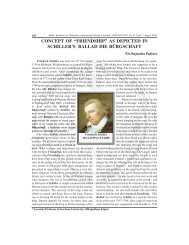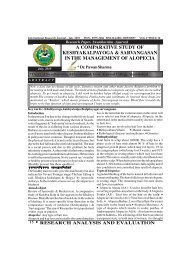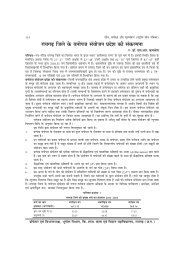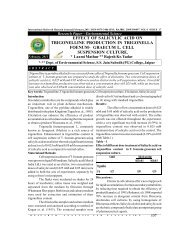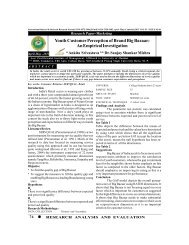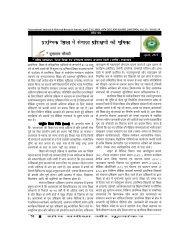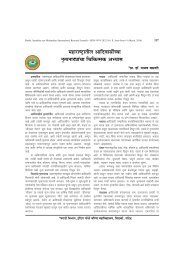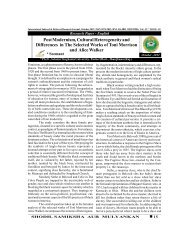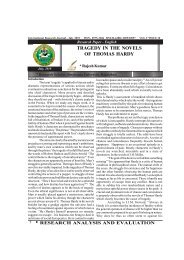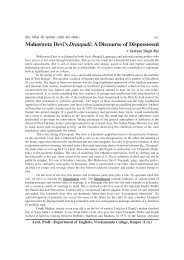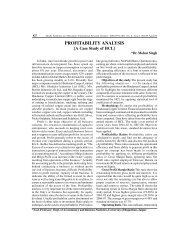Mother and Child Health - international indexed refereed research ...
Mother and Child Health - international indexed refereed research ...
Mother and Child Health - international indexed refereed research ...
You also want an ePaper? Increase the reach of your titles
YUMPU automatically turns print PDFs into web optimized ePapers that Google loves.
International Indexed&Referred Research Journal,Sept,2012.ISSN-0975-3486,RNI-RAJBIL 2009/30097;VoL.IV*ISSUE-36<br />
Research Paper—Social Work<br />
<strong>Mother</strong> <strong>and</strong> <strong>Child</strong> <strong>Health</strong> :<br />
A study of BPL families with Social Work Perspective.<br />
* Pattan Rakesh ** Dr. K S Mali Patil<br />
September,2012<br />
* Research Scholar, Dept of Social Work, Gulbarga University, Gulbarga<br />
* * Chairman,Dept of Social Work, Gulbarga university, Gulbarga.<br />
A B S T R A C T<br />
The present <strong>research</strong> paper aims to explore the health status of the mother <strong>and</strong> its impact on the children. <strong>Mother</strong>’s poor health <strong>and</strong><br />
nutritional status in India are inextricably bound up with social, cultural <strong>and</strong> economic factors. These factors severely constrain the ability<br />
of mothers to acquire good health services. Such conditions have consequences not only for the women themselves but also for the well<br />
being of their children, the functioning of households <strong>and</strong> the distribution of resources. These include unequal access to resources<br />
including health care, rural/urban residence, work status, caste <strong>and</strong> religion, poor quality of life, low literary rate, marriage at young age<br />
etc. Hence, there is an urgent need to reorient population programme priorities to focus on health needs <strong>and</strong> on women based services.<br />
Key words: <strong>Mother</strong> <strong>and</strong> <strong>Child</strong> <strong>Health</strong>, Nutrition , Comman <strong>Child</strong> hood illness <strong>and</strong> deficiency diseases<br />
Introduction<br />
aspects of mothers in BPL families.<br />
‘<strong>Child</strong>ren are future of the society <strong>and</strong> Significance of the Study<br />
mothers are guardian of that future (WHO 2005). The concept of mother <strong>and</strong> child health today<br />
Hence to ensure sound foundation <strong>and</strong> secure future has become a major concern because at its impact on<br />
of any society health <strong>and</strong> nutrition of mothers need nation. <strong>Health</strong> <strong>and</strong> nutritional status especially in BPL<br />
protection. <strong>Child</strong>ren in preschool stage require most families it contributes high prevalence at infant, child<br />
attention as this is the period of rapid growth <strong>and</strong> <strong>and</strong> maternal mortality <strong>and</strong> the deteriorating quality<br />
development which makes them highly vulnerable to of life.<br />
malnutrition.<br />
India has made a slow <strong>and</strong> steady progress in<br />
During preschool period child is mostly dependent on human development ever since independence. Severe<br />
mother for all their nutritional needs. Hence major <strong>and</strong> florid forms of malnutrition have declined<br />
care provided for the child, her status in the family substantially, infant mortality has declined from 146<br />
may have bearing on nutritional status of her child per 1000 live births (1951) to 69 per 1000 live births<br />
(World Bank 1994, Guha B et al 2006). But health (2000), life expectancy has risen from 37 years to 63<br />
<strong>and</strong> nutritional status of mothers itself a complex years <strong>and</strong> we have achieved self sufficiency in food<br />
concept <strong>and</strong> includes various areas including social, production. In spite of all these impressive<br />
economical, autonomy, reproductive right, health <strong>and</strong> developments on records, one third of newborns start<br />
well being etc., ( amy caiazza 2009, smith l.c. et al their life with low birth weight, more than half of<br />
2004). In this context the present Article is an attempt young children below five years of age continue to<br />
to know the mother <strong>and</strong> child health a study of BPL suffer from moderate <strong>and</strong> severe malnutrition, over<br />
families.<br />
60% of women are anemic <strong>and</strong> this figure rises to 85%<br />
Objectives of the Study:<br />
during pregnancy state, 40-60% of adolescent girls<br />
The aim of the study is to explore health status of the tend to be anemic. Malnutrition is thus wide spread in<br />
mother <strong>and</strong> its impact on the children. To achieve the rural, tribal <strong>and</strong> urban slum areas <strong>and</strong> it is a significant<br />
aim study the following objectives are formulated. public health problem described as silent killer, silent<br />
1. To study the personal background of the <strong>Mother</strong> emergency, invisible enemy affecting those who cannot<br />
<strong>and</strong> <strong>Child</strong><br />
express, their voice <strong>and</strong> have to depend upon others<br />
2. To examine health status of the mothers <strong>and</strong> their for their advocacy.<br />
offspring’s with special reference to nutrition<br />
Poor nutritional status intake of mother is<br />
3. To explore the impact of <strong>Mother</strong>s’ health on the often co-related with poor economic status, nutritional<br />
<strong>Child</strong>ren<br />
deprivation high risk of pregnancy such as maternal<br />
4. To identify prevalence of ill health <strong>and</strong> Complications <strong>and</strong> deaths low birth weight babies<br />
malnutrition of the mothers in BPL families <strong>and</strong> premature births. According to the N.F.H.S-II the<br />
5. To suggest the Social Work intervention module infant mortality rate (IMR) in Karnataka is 52 per<br />
to the issues of health <strong>and</strong> nutrition of poor families 1000 births which is much lower that the national<br />
RESEARCH ANALYSIS AND EVALUATION<br />
63
International Indexed&Referred Research Journal,Sept,2012.ISSN-0975-3486,RNI-RAJBIL 2009/30097;VoL.IV*ISSUE-36<br />
IMR of 68. Hence it is very significant <strong>and</strong> vital to<br />
study the mother <strong>and</strong> child health: A study of BPL<br />
families in north Karnataka. Till now only a few studies<br />
have been conducted in this area.<br />
As per <strong>research</strong>er’s knowledge, in India no such studies<br />
were undertaken to know about mother <strong>and</strong> child<br />
health: A study of BPL families, hence the study intends<br />
mother <strong>and</strong> child health.<br />
Statement of the problem<br />
The issues of mother <strong>and</strong> child health were<br />
the neglected areas in health care. These issues came<br />
into prominence with the <strong>international</strong> conference<br />
with the <strong>international</strong> conference on population <strong>and</strong><br />
development at Cairo in 1994 <strong>and</strong> Fourth world<br />
conference of women at Beginning in 1995.<br />
As data available in Karnataka shows that<br />
there is no evidence of gender bias in food distribution<br />
among the children but the same time the nutritional<br />
requirements of mothers are not fully met. Anemia<br />
among the women, Iron deficiency is the most<br />
widespread for at malnutrition in the world affecting<br />
more than two billion people. In Karnataka the<br />
hemoglobin level was tested from 94 percent of the<br />
women compared with 88 percent in India as a whole.<br />
Anemia has detrimental effects on the health of women<br />
<strong>and</strong> children <strong>and</strong> can become an underlying cause of<br />
maternal mortality, ante-natal mortality, <strong>and</strong> increased<br />
risk of pre-mature delivery.<br />
Mortality of infants can not be isolated from<br />
women has a very high level of infant mortality rate<br />
(IMR) in Karnataka that is 52 per 1000 live births<br />
which is much lower than the national IMR at 68.<br />
On account at prosperity <strong>and</strong> changing life style in<br />
urban areas, obesity is emerging as substantial problem<br />
among several groups of women in India on the basis<br />
of BMI,NFHS-2 data indicates that overall 10.6 %<br />
women between 15-49 years were obese <strong>and</strong> obesity<br />
was more pronounced in Delhi (33.8%), Punjab<br />
Chronic energy deficiency in women at 15-49 years is<br />
prevalent to the extent at 36%. Who have BMI value<br />
less than Anemia among pregnant women continues<br />
to be unabated, as 84.9% of pregnant women were<br />
found to be anemic according to ICMR study<br />
undertaken in 16 districts at 13 states? Prevalence of<br />
goiter among 6-12 years children were 4.78 % <strong>and</strong><br />
night blindness in children (24-71 months of age)<br />
were 1.03 % <strong>and</strong> bitot spots <strong>and</strong> night blindness were<br />
reported to be of the level of 0.34 % <strong>and</strong> 0.7%<br />
respectively. Similarly prevalence of Iodine deficiency<br />
disorders (IDD) in the country is widespread, over<br />
300 million people are exposed to the risk of goitre,54<br />
million have goiter 2.2 million are born cretins And<br />
6.6 million have mild neurological disorders 12 overall<br />
prevalence rate of vitamin ‘A’ deficiency in India has<br />
been reported as 0.21 %.<br />
Malnutrition results from combination of causes or<br />
factors <strong>and</strong> condition how birth weight arise on account<br />
of poor nutritional state of pregnant women.<br />
Malnutrition in young children can be women are<br />
mainly due to inadequate eating <strong>and</strong> discriminators<br />
food customs.<br />
In this context, the present study aimed at study the<br />
mother <strong>and</strong> child health: A study of BPL families in<br />
north Karnataka.<br />
Conclusion<br />
For the above mentioned reasons, the health of women<br />
is being understood in terms of maternal mortality<br />
<strong>and</strong> reproductive health.. It projects a mother <strong>and</strong> not<br />
a woman. To underst<strong>and</strong> woman’s health holistically,<br />
it is important to look into the morbidities which are<br />
not only related to reproduction but are social, mental<br />
<strong>and</strong> spiritual. In the new millennium when life<br />
expectancy for woman is continuing to rise <strong>and</strong> they<br />
are living longer, it is therefore important that they<br />
have access to knowledge related to their own health<br />
<strong>and</strong> are able to have control over all aspects of her<br />
(30.2%), kerala (20.6%), Haryana<br />
body along with her reproductive system.<br />
(16.66%), Karnataka (13.6%).<br />
R E F E R E N C E<br />
1. Sujata Mithal <strong>Health</strong> <strong>and</strong> nutrition for the school age child.<br />
2. Appoh LY, Krekling S. Maternal nutritional knowledge <strong>and</strong> child nutritional status in the Volta region of Ghana. Matern <strong>Child</strong> Nutr.<br />
2005 Apr;1(2):100-10<br />
3. Basudeb Guha-Khasnobis <strong>and</strong> Gautam Hazarika. Women’s status <strong>and</strong> <strong>Child</strong>ren’s Food Security in Pakistan.UNU-WIDER, Discussion<br />
Paper No. 2006/03. June 2006.<br />
4. Olga Basso, Jorn Olsen, Anne Mette T Johansen, Karre Christensen. Change in social status <strong>and</strong> risk of low birth weight in Denmark:<br />
population based cohort study. BMJ 1997;315:1498-1502 (6 December).<br />
5. Sakisaka K, Wakai S, Kuroiwa C, Cuadra Flores L, Kai I, Mercedes Aragon M, Hanada K. Nutritional status <strong>and</strong> associated factors<br />
in children aged 0-23 months in Granada, Nicaragua. Public <strong>Health</strong>. 2006 May;120(5):400-11.<br />
6. World Bank, A new agenda for Women’s <strong>Health</strong> & Nutrition 1994; 1-96<br />
7. World <strong>Health</strong> Organization, Make every mother <strong>and</strong> child count WHO Report 2005<br />
64 RESEARCH ANALYSIS AND EVALUATION



